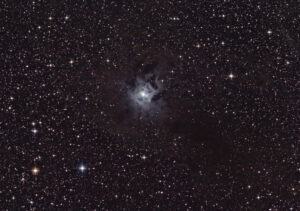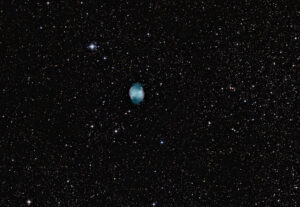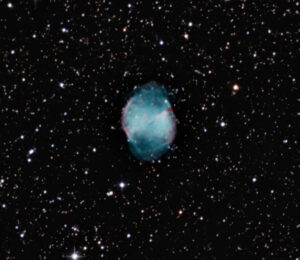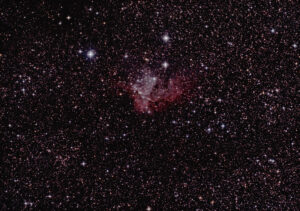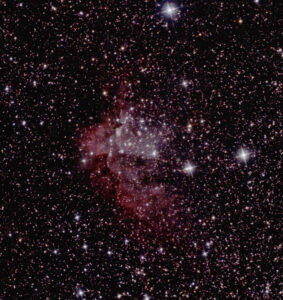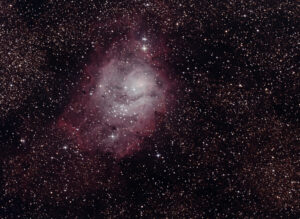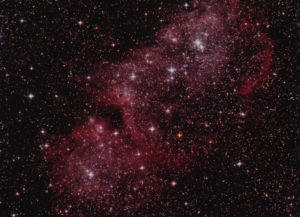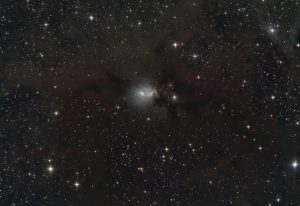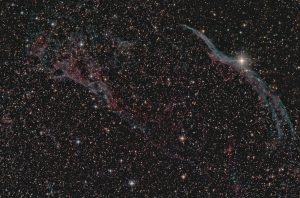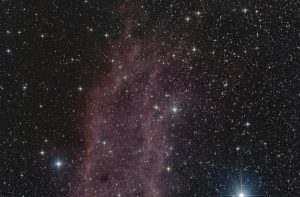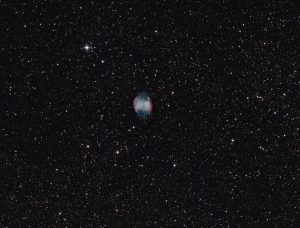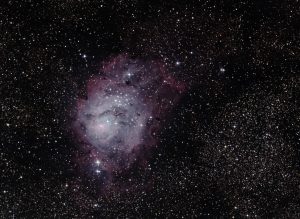The Iris Nebula is a hauntingly beautiful target. I was able to get well over three hours total of 240 second sub frames. Stacked with “2x drizzle” and fresh calibration flat frames along with bias frames. Ran two different post processing runs and this one was the one I liked best. As always when you click the image below it will open up the full resolution image.
Category: Nebulas
Another go at this nebula that is hard to pull out of the starfield with my current setup. The “Wizard” profile is not easily discerned in this image and the distinguishing feature of the pointed hat is not evident here to be honest. In any case I ran 240 second subs with nearly 3 hours of integration to produce this version. Pushing the post processing as far as I could makes for some funky star artifacts. One near full field and one rotated crop image:
A very low target in the Southern sky from my location, the Lagoon Nebula is rather bright so I went with 180 second exposures at 800 asa. I stacked something like 38 subs or about 1.9 hours of data. Tracking was unusually poor with steady periodic swings. Some of this may be from the low physical orientation of the mount and some may be from the atmosphere although the sky in general seemed to have stable air. In another move that I have not done much if at all in this blog, I used the “2x drizzle” function while stacking the sub exposures. This gives an output with double the resolution. After initial conversion to 16 bit the image scale is reduced back to normal scale and the effect is a sharper image to start off with.
Half of the “Heart and Soul Nebula” in this frame from a 3 hour run on a dark sky night.
From the internet….. https://www.constellation-guide.com/soul-nebula/ :
“The Soul Nebula (Westerhout 5) is an emission nebula located in the constellation Cassiopeia. It forms a famous pair known as the Heart and Soul with the neighbouring Heart Nebula (IC 1805). The Soul Nebula is sometimes also known as the Embryo Nebula or IC 1848, which is a designation used for the open star cluster embedded within the nebula.
The Heart and Soul Nebulae complex spans an area about 300 light years across and is a vast star-forming region illuminated by the light of the young stars surrounded by star-forming clouds of dust and gas. The two large clouds are separated by only 2.5 degrees and physically connected by a bridge of gas. The stars in the region are less than a few million years old and are only beginning their life. For comparison, our Sun has been around for almost 5 billion years.”
From October 30th I was out for a long night and ended with 38 frames of 360sec each, a total of almost 4 hours. My longest run yet! I might try processing again since it seems this should have more color from others images but most people over saturate reality in my opinion.
From the webs…..
Embryo Nebula NGC 1333 a beautiful reflection nebula, dominated by bluish hues characteristic of starlight reflected by interstellar dust. It lies at the edge of the Perseus molecular cloud complex at a distance of about 1000 light-years and is an active star-forming region.
From ten days ago the California Nebula.
Well at least part of it! Around 28 good frames at 300 seconds each and for the first time initial integration thru the program Siril. I first was following a youtube video on using the program but felt the non linear functions were too harsh so I ran it again with the linear functions and then went to photoshop for the processing I am familiar with. This set used dithering on the light frames and a new flat frame set along with a bias set allowing Siril to do its thing with the whole bunch. Produced an initial integrated stack in just two minutes so that was impressive use of my main desktop running an AMD Ryzen 5 2600X Six-Core Processor 3.60 GHz and 16gig memory. The result seems superior to DSS images from the past, though I am now more convinced my coma corrector is lacking. The star spikes have a double edge to them which I am finding in the forums a weakness of the Baader 2″ MPCC Mark III along with the arrows near the edges.
The sky is dark with just a sliver of a moon setting in the evening and our smokey skies fairly clear for a short time, so I set up to image and found the Dumbbell Nebula a solid target for a little over 2 hours of 360 second frames. Each time revisiting a target like this is a small step forward in my experience and of course some great time under the night sky. On this occasion I had a pair of new 10×50 binoculars to scout the heavens and our human creations streaming by. Reminders of the eternal and the transient reality.
The Lagoon Nebula is a giant interstellar cloud in the constellation Sagittarius is classified as an emission nebula. Discovered by Giovanni Hodierna before 1654 it is one of only two star-forming nebulae faintly visible to the eye from mid-northern latitudes. This is rather low in the southern sky for me and not the best part of the sky to collect images most nights. I took a chance at getting enough clean frames and I am so impressed at the result!
One hour 25 minutes of 300 second frames at ISO800. Warm temperatures but near new moon and rather clear air for this time of year. Very little smoke or moisture interfering with the horizon.
